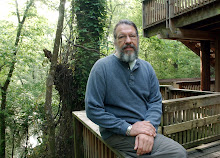Northern Flicker showing off its shafts...
(photo by Larry Amy)
Down-river pal Larry Amy recently sent in some nice backyard bird photos from his place on the Vermilion River in Lafayette. Serendipitously, all of the photos featured birds that nest only sparingly here in the cusp of the coastal zone and southern-interior of Louisiana. Most of you are probably familiar with these birds; but chances are that you locals observe them more in fall/winter than in summer. That's because – for reasons unknown – very few pairs of each of these species decide to nest down at this latitude in any given year. It would seem that both food resources and nesting habitat for each of these birds can be found in good supply here in south Louisiana – possibly to an even greater degree than they can be found at the northern ends of their respective breeding ranges. So what's the deal?
Ah, Nature.
The first feature bird is the Northern Flicker. In Larry's photo above, you can readily see how it got its alternative common name, the Yellow-shafted Flicker. Pretty fine, non? “Yellow Hammer” is another common name – one which we used as kids growing up in Ville Platte. 'Course, being from Ville Platte, we pronounced it, “yella hammuh.”
"Yella Hammuh" preparing to hammer...
(photo by Larry Amy)
The few Northern Flickers that I've detected nesting down here over the years have been confined to urban forests – places in towns and cities hosting large neighborhoods of big, mature shade trees. Come October, though, and Yellow-shafted Flickers flood into our region from all over; and their piercing, “KYEAR!” cries can be heard all through the fall and winter months.
More than any other woodpecker, flickers spend much time on the ground gobbling up bugs and other arthropods – including ants. There's a well-told story amongst bird people about gut-analysis performed on the stomach of a single flicker which turned up 5,000 ants(!).
Lydia calls the Belted Kingfisher, the "Blue Monseiur"
due to its fancy hairdo...
(photo by Larry Amy)
Feature bird number two is the Belted Kingfisher, a wetland-associated bird that tunnels into steep stream banks to make its nest. And when I say “tunnel” I mean TUNNEL; for the average tunnel length is three to four feet, with one as long as twelve feet being reported (see Oberholser's Bird Life of Louisiana, 1938). Again, there seems to be no shortage of steep stream banks down here, so why don't we host more nesting kingfishers? Fortunately, Dan Debaillon Coulee (“coulee” is a Cajun word for “gulley” or intermittent stream, ya'll; from the French, couler [“to run”]), which runs right below the north deck of the Acadiana Park Nature Station in Lafayette has handsomely-steep banks, and hosted a pair of nesting Belted Kingfishers for most of the twenty-four summers that I worked there.
Hollerin' Red-tailed Hawk
(photo by Larry Amy)
And then there's the good old Red-tailed Hawk, which enjoys one of the most cosmopolitan breeding range of any North American bird. Southern Louisiana is a winter epicenter for this species. Swamp edges, ag-field edges, meadow edges, pipeline and utility-line rights-of-ways, and roadsides of any sort are all good locations for this bird, which flocks into Louisiana by the thousands (if not tens-of-thousands) each fall and winter. Come summer, though, and Red-tailed nests are few and far-between in these parts. Larry's fortunate enough to have a nesting pair somewhere very near to his Lafayette backyard.






Great pictures, Larry. And great writing, Bill... as usual.
ReplyDelete